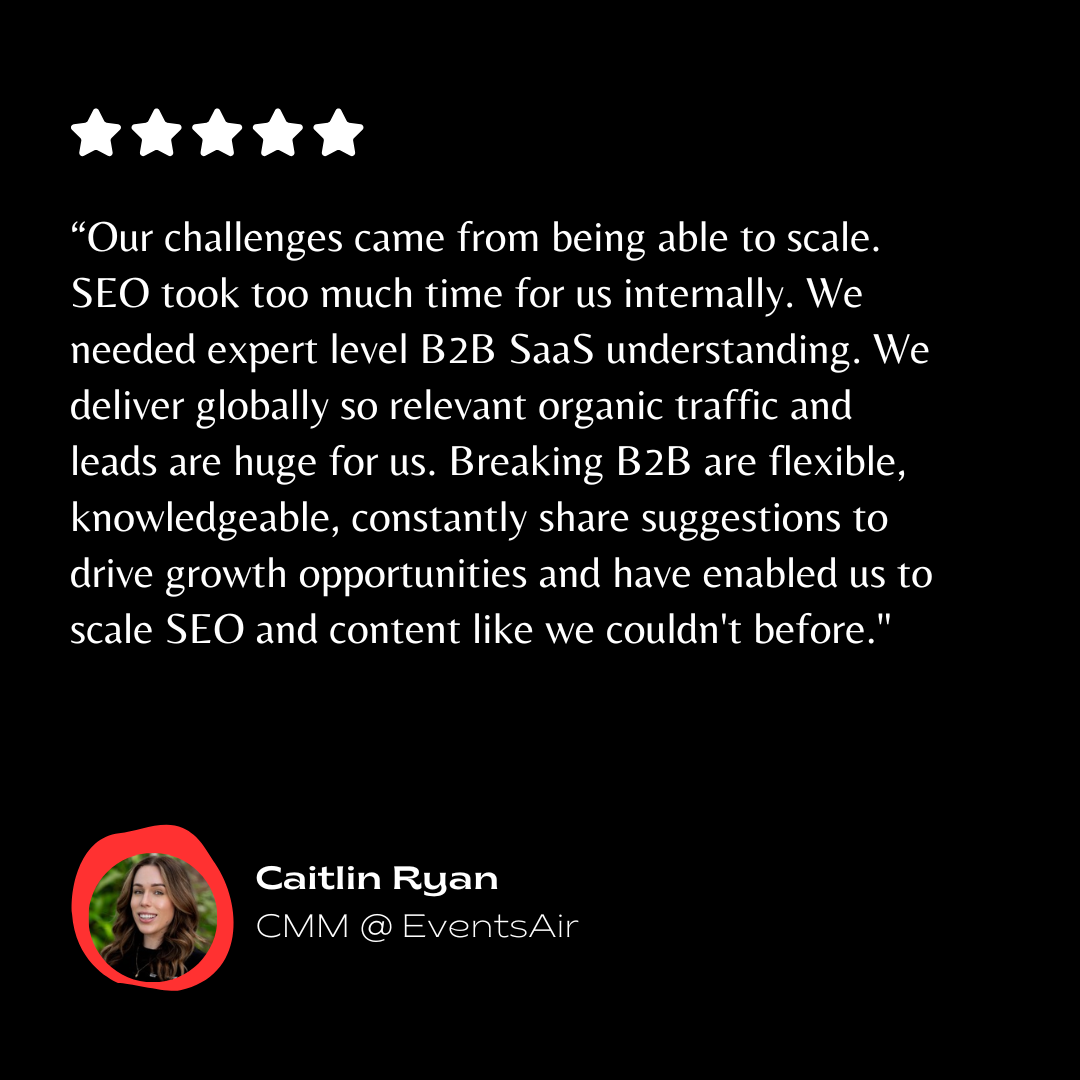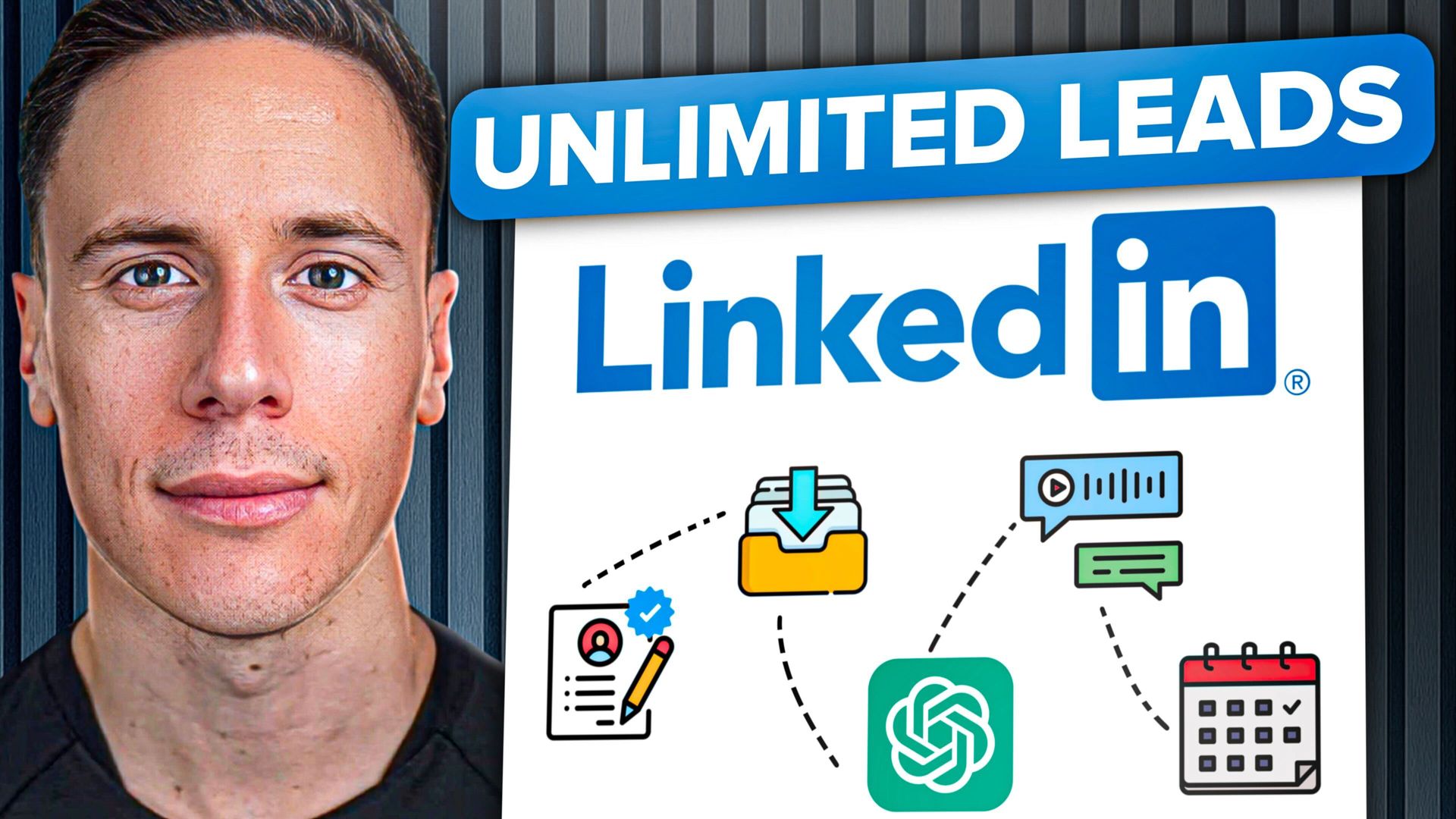Table of Contents
Ready To Grow Organic Pipeline & Revenue?
See if we can scale your organic pipeline from SEO as quick as 90 days.
Quick Summary
Struggling to Rank for Keywords That Convert?
Most B2B companies treat SEO like a number game. They obsess over keyword rankings and organic traffic even while their sales team struggles with low-quality leads that never convert.
Here's the truth: B2B SEO isn't about ranking for every possible keyword. It's about capturing high-intent prospects when they're actively searching for solutions like yours.
After working with B2B companies like Wildsparq, EventsAir, and Checkwriters, we've seen what separates SEO that drives revenue from SEO that just looks good in reports. In this
Breaking B2B guide, you’ll discover the boxes your company must check to succeed in SEO marketing.
Why Listen to Us?
We've helped
dozens of B2B tech and service companies scale their organic lead generation. Our clients don't just see traffic increase, they see qualified leads that convert into customers and drive measurable revenue growth. Companies like Checkwriters, EventsAir, and Wildsparq have scaled their SEO and content beyond what they thought possible.

Why Is B2B SEO Important?
B2B SEO is the process of optimizing your website to rank for search terms your ideal customers use when researching solutions. Unlike B2C SEO, B2B SEO focuses on longer buying cycles, multiple decision-makers, and high-value transactions.
The goal isn't about obsessing over massive traffic volumes. Instead, it's attracting the right prospects at the right time with content that moves them through your sales funnel. B2B buyers conduct extensive research before making purchasing decisions, often involving multiple stakeholders and lengthy evaluation periods.
Here’s how effective B2B SEO addresses these unique challenges:
Revenue-Driven Lead Generation
SEO captures prospects when they're actively searching for solutions. These inbound leads convert 8x better than outbound leads because they're already interested in what you offer. They've identified a problem and are actively researching solutions, making them much more qualified than cold prospects.
Sustainable Growth Channel
Unlike paid ads that stop working when you stop paying, SEO compounds over time. Quality content and optimized pages continue generating leads months and years after publication. This creates a sustainable competitive advantage that becomes harder for competitors to replicate.
Cost-Effective Scaling
SEO costs less per lead than most other channels. Once you rank for valuable keywords, you can generate consistent leads without ongoing ad spend. The initial investment in SEO pays dividends for years, making it one of the most cost-effective marketing channels for B2B companies.
Our 15 Essential B2B SEO Steps To Generate Warm Leads
1. Conduct Bottom-of-Funnel Keyword Research
Start with keywords that indicate buying intent. Focus on terms like "best [solution]," "[product] alternatives," or "[category] software." These searchers are closer to making purchase decisions than those searching for general information.
You can use tools like Ahrefs or SEMrush to find keywords with commercial intent to look for terms your competitors rank for and you don't. These represent immediate opportunities where you can steal market share.
Also, prioritize keywords based on
search volume,
difficulty, and
business value. A keyword with 100 monthly searches that converts at 5% is more valuable than one with 1,000 searches that converts at 0.5%.
2. Optimize Your Homepage for Primary Keywords
Your homepage should target your most valuable keyword, typically your main product or service category. Include this keyword in your title tag, H1, and throughout the content naturally.
Don't keyword stuff. Write for humans first, and search engines second. Your homepage should clearly communicate what you do, who you serve, and why prospects should choose you over competitors.
Include social proof like client logos, testimonials, and case study results. B2B buyers need to trust your company before they will engage with your sales team.

3. Create Product-Led Content
Develop content that showcases your product solving real problems. Case studies, product demos, and how-to guides perform better than generic industry articles because they demonstrate actual value.
This content should target bottom-funnel keywords and include clear calls-to-action. The goal is to move prospects from research to trial or demo. Show don't tell, demonstrate your solution in action.
Focus on use cases that resonate with your target audience. A detailed case study showing how you helped a similar company achieve specific results is worth more than ten theoretical articles.
4. Build Relevant, Niche Backlinks
Focus on earning links from industry publications, partner sites, and relevant blogs. One link from a respected industry source beats 10 links from random directories.
Create linkable assets like research reports, industry surveys, or comprehensive guides. These naturally attract backlinks from other sites in your space. Original research and data-driven insights are particularly effective for earning quality backlinks.
You can also develop relationships with industry journalists and bloggers. Offer expert commentary on trends and news in your space. This builds authority and generates natural link opportunities.
5. Optimize for Local Search (If Applicable)
If you serve specific geographic markets, optimize for local SEO. Claim your Google Business Profile and ensure consistent NAP (Name, Address, Phone) information across directories.
Target location-based keywords like "[service] in [city]" or "[city] [industry] solutions." Many B2B buyers prefer working with local providers, especially for services requiring on-site work.
Create location-specific landing pages for each market you serve and make sure to include local testimonials, case studies, and relevant geographic keywords.
6. Implement Technical SEO Fundamentals
Fix crawl errors, optimize site speed, and ensure mobile responsiveness. Technical issues prevent search engines from properly indexing your content, wasting all your other SEO efforts.
Use tools like Google Search Console to identify and fix technical problems. A fast, crawlable site is the foundation of good SEO. Even the best content won't rank if search engines can't access it.
Implement SSL certificates, create XML sitemaps, and optimize your robots.txt file. These technical elements signal to search engines that your site is professional and trustworthy. For more insights on this, visit our blog post on Technical SEO for SaaS.
7. Create Comprehensive Service Pages
Each service you offer should have a dedicated page targeting relevant keywords. These pages should explain what you do, how you do it, and why prospects should choose you.
Include testimonials, case studies, and clear CTAs on every service page. These pages often convert better than blog posts because they target prospects further down the funnel.
Structure service pages with clear headings, bullet points, and scannable content. B2B buyers often skim content initially, so make key information easy to find.
At Breaking B2B, we specialize in creating content that meets SaaS buyers at the bottom of the funnel, where pipeline is made. This includes building out competitor comparison pages, use-case breakdowns, and feature-specific landing pages that tie directly to qualified leads.
We did this for Cerbos, a security-focused SaaS tool, which led to a 48.3% year-over-year increase in organic impressions.

8. Optimize for Featured Snippets
Target featured snippets for high-value questions in your industry. Structure content with clear headings, bullet points, and concise answers.
Featured snippets can dramatically increase your click-through rates and establish authority in your niche. They position your brand as the go-to source for industry information.
You can research questions your prospects commonly ask and create content that directly answers them. Also use tools like AnswerThePublic to find question-based keywords in your industry.
9. Develop a Content Hub Strategy
Create comprehensive resource sections around your main topics. This internal linking structure helps search engines understand your expertise and improves rankings.
Link related content together and use descriptive anchor text. This passes authority between pages and improves user experience. A well-structured content hub can establish topical authority faster than scattered blog posts.
Organize content by buyer journey stage and business function. This helps prospects find relevant information quickly and demonstrates your understanding of their needs.
10. Monitor and Improve Core Web Vitals
Google's Core Web Vitals affect rankings and user experience. Monitor your site's loading speed, interactivity, and visual stability.
Use tools like PageSpeed Insights to identify improvement opportunities because fast sites rank better and convert more visitors. B2B buyers expect professional, fast-loading websites.
Optimize images, minify code, and leverage browser caching. These technical improvements directly impact both SEO performance and user experience.
11. Create Comparison and Alternative Pages
Target high-intent keywords like "[competitor] alternative" or "[product] vs [competitor]." These pages capture prospects comparing solutions and represent high-value conversion opportunities.
It’s important to be honest about strengths and weaknesses. Prospects researching alternatives appreciate balanced comparisons more than biased sales pitches. Transparency builds trust and credibility.
Include detailed feature comparisons, pricing information, and customer testimonials to help prospects make informed decisions.
12. Optimize for Voice Search
More B2B buyers are using voice search for initial research. Optimize for natural language queries and question-based keywords.
Create FAQ sections that answer common questions in conversational language. This content often ranks well for voice searches and provides value to site visitors.
Make sure to focus on long-tail keywords that mirror natural speech patterns, as voice searches tend to be more conversational and question-based than typed queries.
13. Implement Schema Markup
Add structured data to help search engines understand your content. Schema markup can improve how your pages appear in search results.
Use organization schema, FAQ schema, and review schema where appropriate. This can increase click-through rates and visibility in search results.
Implement local business schema if you serve specific geographic markets. This helps search engines display accurate business information in local search results.
14. Track Revenue-Focused Metrics
Monitor metrics that matter for B2B success: qualified leads, conversion rates, and revenue attribution. Traffic alone doesn't indicate SEO success.
Use tools like HubSpot or Salesforce to track which organic traffic converts into customers. This data helps prioritize future SEO efforts and demonstrates ROI to stakeholders.
Set up conversion tracking for key actions like demo requests, trial signups, and contact form submissions. Understanding what drives conversions helps optimize your entire funnel.
15. Continuously Audit and Optimize
SEO is ongoing work. Regularly audit your site for technical issues, content gaps, and new keyword opportunities.
Set up monthly reports tracking your most important metrics. You can use this data to refine your strategy and stay ahead of competitors. The SEO landscape changes constantly, so you need continuous adaptation.
Schedule quarterly comprehensive audits to identify new opportunities and address emerging issues. Regular optimization maintains and improves your search visibility over time.
Turn SaaS Audit Insights Into Revenue
B2B SEO success comes from focusing on targeting keywords that indicate buying intent, creating content that showcases your expertise, and building authority through relevant backlinks.
Remember: good B2B SEO takes time, but the results compound. Start with these 15 steps, and you'll build a sustainable lead generation channel that works while you sleep.
Better yet, let Breaking B2B manage your B2B SEO success. With proven experience helping businesses like Checkwriters and Wildsparq, we tailor strategies that deliver lasting results.
Ready to boost your B2B SEO?
Book a call today to get started!







